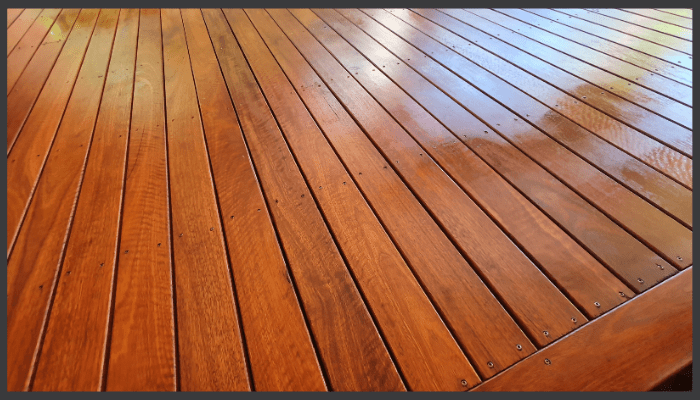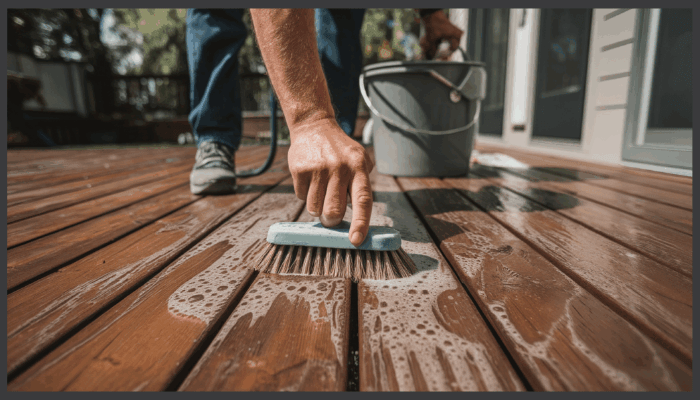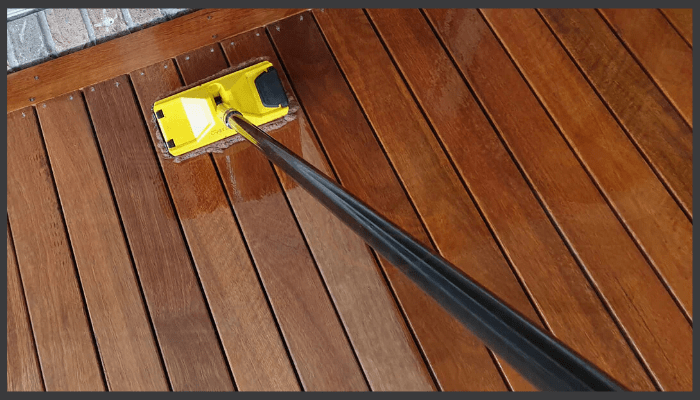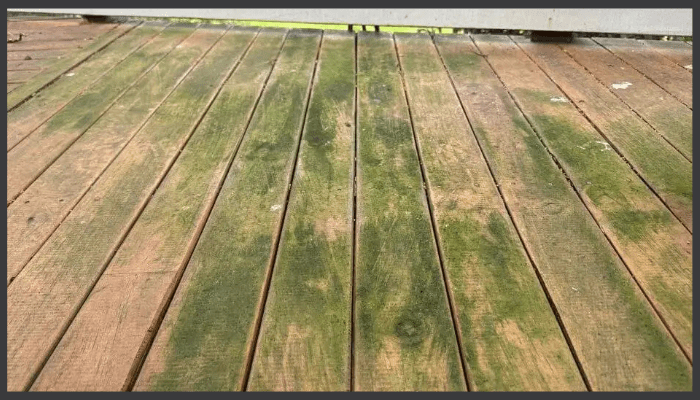How to Maintain and Seal Spotted Gum Decking
How to Maintain and Seal Spotted Gum Decking
Table of Contents:
-
Why Regular Maintenance is Key for Spotted Gum Decking in Canberra
-
Step-by-Step Guide to Maintain and Seal Your Spotted Gum Deck
-
Choosing the Right Decking Oil for Spotted Gum
-
Applying Decking Oil: Tips for a Flawless Finish
- Caring for Your Deck Throughout the Year
- Protecting Your Deck from the Elements
- Frequently Asked Question
Spotted gum is one of Australia’s most popular hardwoods for good reason.
It’s naturally attractive, extremely durable, and features distinctive grain patterns that stand out in any outdoor setting.
Whether you’re installing a new spotted gum deck or looking after an older one, proper care and sealing are essential to keep it looking its best—especially with Canberra’s harsh seasonal weather.
Without regular maintenance, even a hardwood like spotted gum can be affected by extreme heat in summer and freezing temperatures in winter.
Browse our range of decking and screening supplies to choose the right materials for your outdoor project.
This guide will help you understand how to maintain your spotted gum decking, which involves knowing about natural oils, selecting the right decking oil, and applying it correctly.
With the right approach, your deck will retain its natural beauty and durability for years to come.
Why Regular Maintenance is Key for Spotted Gum Decking in Canberra
Timber decking maintenance is essential for keeping your spotted gum looking its best.
Without proper oil penetration, even high-quality hardwood can become weathered and worn over time.
Sun exposure, rain, dirt, and regular foot traffic all contribute to surface fading and damage, gradually stripping away the timber’s natural colour.
Canberra’s climate presents additional challenges.
Harsh UV rays, cold overnight temperatures, and moisture from frost or rainfall can all impact your deck if it’s not properly sealed and maintained.
Without regular care, spotted gum decking becomes more vulnerable to cracking, staining, mould, and even termite activity.
As a general rule, schedule maintenance for your spotted gum decking at least once a year.
If your deck receives heavy use or is exposed to direct sunlight for most of the day, more frequent care may be necessary.
Regular cleaning and resealing will help preserve its strength, colour, and visual appeal over the long term.
Step-by-Step Guide to Maintain and Seal Your Spotted Gum Deck
1. Cleaning Off Dirt, Dust, and Mould
First things first: your deck needs to be clean.
Grab a stiff broom or blower and evict all those freeloading leaves, and mystery debris that have been squatting on your surface.
For a deeper clean of weathered timber decking, consider using a timber cleaner like Diggers Timber Cleaner, which effectively removes tough stains and restores your boards' natural colour.
Feast Watson Woodclean is another effective deck cleaner that helps remove oils, mould, stains, and tannins from new and weathered timber.
This magical potion removes tough stains and restores your boards' natural colour. It works fast, and the change is truly beautiful.
2. Remove Old Oil and Stains
Got old oil residue clinging to your deck?
Time for an oil remover intervention.
Strip away those previous coatings to ensure your new decking oil can actually do its job instead of sitting on top.
Those mould and water damage stains need specialised cleaners too, because regular soap won't cut it.
3. Sanding the Deck Surface
Light sanding is like exfoliating for your deck: it removes rough patches and opens up those wood pores for maximum oil absorption.
Always sand along the grain, and remove all sanding dust afterward. Leaving it there defeats the purpose!
4. Selecting the Right Time
Timing your deck maintenance more critical.
Aim for that Goldilocks zone between 15°C and 25°C, with zero rain predicted for at least 24 hours.
Trying to seal your deck when it's too hot, cold, or humid isn't going to turn out well!
Choosing the Right Decking Oil for Spotted Gum
Choosing the right decking oil, including intergrain products, for your spotted gum is a key decision that impacts both its appearance and durability.
The ideal product should suit your aesthetic preferences while also standing up to Canberra’s harsh climate.
See our selection of timber oils and sealants tailored for hardwood decking.
UV exposure, temperature fluctuations, and seasonal rain all take a toll on outdoor timber, so the oil you choose plays an important role in long-term protection.
Oil-Based vs Water-Based Sealers
Oil-based decking oils provide deep penetration and long-lasting protection.
They’re ideal for hardwoods like spotted gum because they absorb into the timber, enhancing the grain and offering a rich, natural finish.
These oils also help protect against cracking and drying caused by sun exposure.
Water-based sealers are quicker to apply and easier to clean up.
Many modern options, such as those from Intergrain, offer good coverage and durability with fewer fumes.
While they may not penetrate as deeply into dense hardwoods, they’re a low-maintenance and more environmentally friendly option.
Clear vs Tinted Oils
Clear decking oils maintain the timber’s natural look but offer limited UV protection.
While they preserve the raw appearance of freshly installed spotted gum, they may leave it more vulnerable to the elements, including sun damage, over time.
Tinted oils or timber stains include UV-blocking pigments that protect the timber from fading and weathering.
They also enrich the colour and bring out the natural grain, making them a popular choice for homeowners wanting both protection and enhanced visual appeal.
Clear vs Tinted Oils
While clear oils can preserve the fresh, raw look of new spotted gum, they offer little UV protection.
A tinted decking oil or timber stain contains pigments that help block UV rays and resist fading, while also highlighting the natural colour and grain of gum decking.
Look for tones that complement the timber's unique character and are specifically formulated for Australian hardwoods.
Recommended Products
- Intergrain UltraDeck Timber Oil
A water-based solution made for Australian hardwoods. It protects without leaving a chemical residue.
-
Intergrain UltraDeck
A water-based solution made for Australian hardwoods. It protects without leaving a chemical residue.
-
Sikkens products
Sikkens Cetol Deck Ultra is an oil-rich, translucent decking finish that penetrates deeply into the timber, providing a luxurious satin finish and long-lasting protection against harsh weather conditions.
-
Cetol Deck
Another Sikkens superstar for when you need high-performance sealing that actually performs.
Always read product instructions.
Focus on drying time (patience is key), coverage area (math is important), and the number of coats (more isn't always better).
This will help you get lasting protection.
Applying Decking Oil: Tips for a Flawless Finish
Achieving a smooth, long-lasting finish with your decking oil requires the right tools, proper technique, and a bit of patience.
Rushing through the process can lead to uneven coverage or poor results.
Whether you’re sealing a new spotted gum deck or refreshing an older one, careful preparation and a steady approach are essential.
Taking the time to do it properly will ensure a clean, professional finish that enhances the appearance and durability of your timber.
Tools You’ll Need:
-
Tools You'll Need:
-
Long-handled applicator or paint brush
-
Drop sheets and gloves
-
Deck cleaner with oxalic acid
-
Sandpaper
-
Bucket or tray
-
1. Apply the First Coat
Give that decking oil a good stir - nobody wants inconsistent colour that looks patchy. Apply thin, even strokes along the boards' length.
Your paint brush becomes an artist's tool for those edges and tricky spots. Don’t overdo it with the oil.
Applying too much can lead to sticky spots. These spots pick up dirt quickly. In warm weather, those lap marks will haunt you!
2. Allow for Proper Drying Time
Patience here pays off. Most oils need 4-12 hours to dry, but always trust the label over your impatience.
Touch-testing is crucial: if it feels tacky, it's not ready, no matter how much you want to move on.
Rushing this step is like taking a cake out early; you'll end up with a gooey mess that defeats the entire purpose.
3. Apply the Second Coat
The second coat isn't optional; it's essential. Use the same smooth technique, working in sections small enough to manage without panic.
This coat is what transforms "decent protection" into "bulletproof defense against Canberra's weather mood swings."
Plus, it makes your timber's natural colour and grain pop.
4. Final Cure and Foot Traffic
Here's where most people blow it: thinking "dry" means "done." Keep everyone off that deck for 24-48 hours minimum, longer if your product demands it.
Some oils need weeks to fully cure, especially when Canberra decides to be cold. Returning furniture too early is like sitting on wet paint; you'll leave marks.
Give your deck the spa recovery time it deserves, and it'll reward you with durability that handles rain, dirt, and UV exposure like a champion.
Caring for Your Deck Throughout the Year
Maintaining your deck after sealing is essential for long-term performance and appearance.
One coat application isn’t enough—consistent care keeps your spotted gum decking looking great and helps it last through Canberra’s changing seasons.
Here’s a practical maintenance routine to follow:
-
Sweep regularly to remove leaves, dirt, and debris before they cause staining or moisture retention.
-
Spot clean after rain to prevent watermarks and mould from forming. Addressing moisture early reduces the risk of long-term damage.
-
Inspect boards periodically for signs of wear, rot, or termite activity. For structural support or edging, our treated pine sleepers are a reliable choice.
-
Reapply decking oil to high-traffic or exposed areas every 6 to 12 months. These areas tend to wear faster and benefit from more frequent touch-ups.
-
Use furniture pads under heavy items to prevent scratches and surface damage. This simple step helps maintain the deck’s appearance, especially in entertaining areas.
Protecting Your Deck from the Elements
Canberra’s weather can be unpredictable—scorching heat in summer, followed by sudden rain or winter chills.
These fluctuations can wear down even the highest quality gum decking if not properly protected. Constant exposure to UV, moisture, and temperature changes can cause fading, warping, and decay.
A quality timber seal is essential for protecting against:
-
UV damage, which causes timber to lose its natural colour over time
-
Moisture exposure, leading to mould growth, warping, and swelling
-
Dirt and debris, which can cause stains and surface deterioration
-
Pests like termites, which are attracted to untreated or poorly maintained timber
To keep your deck in good condition, sealing alone isn’t enough. Regular maintenance is key:
-
Clear away fallen leaves and water puddles to prevent moisture buildup.
-
Clean off dirt regularly to avoid staining.
-
Trim surrounding plants to allow sunlight and airflow around the deck.
-
Monitor high-traffic areas and spots under furniture, as these tend to wear faster.
-
When you notice grey patches, dry areas, or fading, it’s time to clean, sand, and reapply decking oil.
Stick to a maintenance schedule of at least once every 12 months, depending on exposure and usage.
This regular care helps your spotted gum decking resist Canberra’s tough climate and ensures it stays strong, safe, and visually appealing for years to come.
Sealing a New Spotted Gum Deck
Fresh spotted gum often comes with natural surface oils that need to be removed before sealing.
Explore our hardwood timber supplies for quality options ideal for outdoor projects.
You have two options:
-
Allow the timber to weather naturally for a few weeks. This gives the surface time to release excess tannins and oils.
-
Use a decking prep solution designed to draw out tannins and clean the surface. This speeds up the preparation process and ensures better absorption of protective products.
Once your deck has weathered or been treated, it’s ready for cleaning and oil remover before sealing.
Take your time during this stage—rushing can lead to poor results and premature wear. Following each preparation step carefully ensures your new deck performs well and maintains its appearance for years to come.
Proper preparation at the beginning reduces the risk of early fading, peeling, or staining and saves you from unnecessary maintenance down the track.
Frequently Asked Question
How often should I seal my timber decking?
As a general rule, reseal your timber deck every 12 months, or every few weeks if subjected to high foot traffic . If your deck receives high foot traffic or is constantly exposed to direct sunlight, it may require more frequent touch-ups to maintain its protection and appearance.
Can I apply a new coat over old oil?
Only if the previous finish is still in good condition. If it’s patchy, sticky, or uneven, it’s best to strip it back before applying a new coat. Recoating over a damaged finish can lead to poor results.
What’s the best way to deal with stains or mould?
Use a deck cleaner containing oxalic acid. It’s effective at removing stains and mould from timber surfaces, helping to restore your deck’s appearance before resealing.
What if I see lap marks?
Lap marks typically occur when oil is applied in hot or sunny conditions. To avoid this, apply decking oil in shaded areas and work in small, manageable sections to ensure an even coat.
Is tinted oil better than clear?
Yes. Tinted decking oils provide UV protection while enhancing the natural grain and colour of your timber. Clear oils offer minimal UV protection and may result in faster fading, especially in sunny areas.
Where to Buy Decking Oils and Supplies in Canberra
If you’re looking for quality decking products in Canberra, visit Pinus Sawmills. We stock a range of cetol deck products, decking oils, stains, applicators, and accessories specifically selected to suit local weather conditions. Our products are designed to protect your timber and enhance its natural beauty.
Whether you’re sealing a new spotted gum deck with the first coat or maintaining an older one, our team offers practical advice and product recommendations tailored to your needs. We’re here to help you get the best results—backed by years of experience.
Visit https://www.pinussawmills.com.au to browse our selection or get in touch for advice. You’ll find the right products for your project, plus expert support every step of the way.




